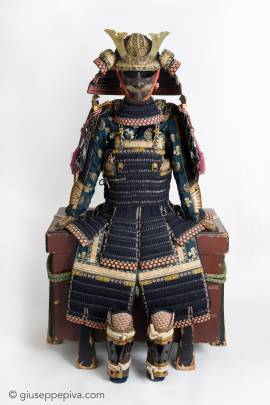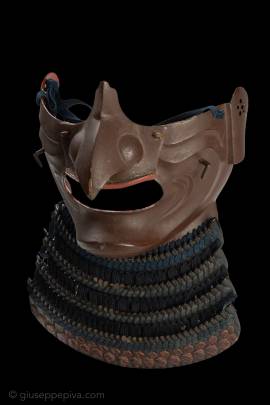Samurai armourEdo period (1615-1867), 18th century SignatureThe menpō is signed under the chin 弘前住 明珍紀宗賢 盛吉作 (Hirosaki no Ju Myōchin ki Munekata Moriyoshi saku) CertificateThe armor accompanied by a certificate of registration as Jūyō Bunka Shiryō(Important cultural work)issued by the Nihon Katchu Bugu Kenkyu Hozon Kai (Association for the Research and Preservation of Japanese Helmets and Armor).Literature:Katchu Bugu Juyo Bunka Shiryo Zuroku - Vol. 4, (Tōken shunjû shinbunsha: Tōkyō, 2004), Pag. 76-77Description:The style of the armor is reminiscent of the medieval suits, as common...
WORKS FOR SALE
Japanese armor with byakudan lacquer PERIODMid Edo period (1615-1868), 18th century EXHIBITIONS: Kimono e Samurai. Il gesto. L'eleganza. Lo spirito, Fondazione Herman Geiger (Cecina) Samurai - Passato e presente, Novara 2012LITERATURE A. Schiavetti (a cura di), Kimono e Samurai. Il gesto. L'eleganza. Lo spirito, Cecina, 2013, p. 20 G. Piva - S. Verrina,Samurai - Passato e presente, cat. A1, Novara 201Japanese armor with byakudan lacquerThis authentic samurai armor features a rare byakudan lacquering, an...
Samurai mask shaped as a TenguMid Edo period (1615-1867)This menpō presents some features, such as the nose shaped like a beak, which suggests that represents the face of a Tengu. The Tengu are mythological creatures of ancient Japanese tradition identify both as kami (gods) and as yokai (demons). They are usually represented as birdman with a long prominent nose or, as in this case, a beak. The mask interior is lacquered and the iron yodarekake is made in four kiritsukezane plates.On this page is a comprehensive glossary of common...
Copyright © 2016 - giuseppe piva - VAT: 05104180962










